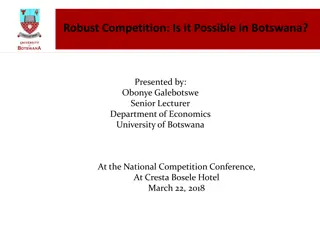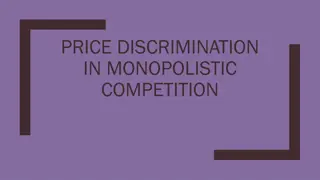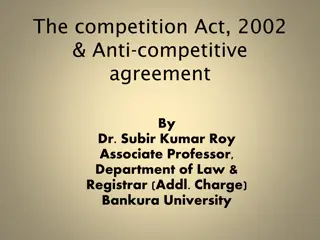Understanding Monopolistic Competition in Market Structures
Monopolistic competition lies between perfect competition and monopoly, where many sellers offer similar but non-identical products. This type of market allows for new firms to enter freely in the long run, enabling product differentiation and individual pricing strategies. Learn about the main features and characteristics of monopolistic competition in this insightful chapter.
- Monopolistic Competition
- Market Structures
- Product Differentiation
- Imperfect Competition
- Entry and Exit
Download Presentation

Please find below an Image/Link to download the presentation.
The content on the website is provided AS IS for your information and personal use only. It may not be sold, licensed, or shared on other websites without obtaining consent from the author. Download presentation by click this link. If you encounter any issues during the download, it is possible that the publisher has removed the file from their server.
E N D
Presentation Transcript
Chapter 16 Monopolistic Competition
Imperfect Competition We have so far seen two kinds of markets: Perfect competition Many buyers Many sellers All sellers sell the exact same product Monopoly Many buyers One seller, the monopolist These are the two extreme cases Imperfect Competition refers to markets in which the degree of competition among sellers falls somewhere in between these extremes 2
Imperfect Competition There are two main types of Imperfect Competition Monopolistic Competition Many sellers They sell products that are similar but not identical New firms can enter freely, in the long run Oligopoly Only a few sellers The product sold may be identical or similar but not identical New firms find it difficult to enter 3
The Four Types of Market Structures Number of Firms? Many firms Type of Products? One firm Few firms Differentiated products Identical products Monopolistic Competition Perfect Competition Monopoly Oligopoly Tap water Cable TV Tennis balls Cigarettes Novels Movies Wheat Milk 4
Monopolistic Competition This chapter focuses on monopolistic competition Main features of monopolistic competition Many sellers Product differentiation: similar but non-identical products Free entry and exit 5
Monopolistic Competition: main features Many Sellers There are many firms competing for the same group of customers. Product examples include books, CDs, movies, computer games, restaurants, piano lessons, cookies, furniture, etc. This feature of monopolistic competition is shared with perfect competition, which we studied in an earlier chapter So, the decisions made by one firm do not affect other firms in any perceptible way 6
Monopolistic Competition: main features Product Differentiation Each firm produces a product that is at least slightly different from those of other firms. As a result, Rather than being a price taker, each firm faces a downward- sloping demand curve. Monopolistic Competition shares this feature with monopoly, which we studied in an earlier chapter Price Demand Quantity 7
Monopolistic Competition: main features Free Entry or Exit Firms can enter or exit the market without any difficulty. As a result, The number of firms in the market adjusts until economic profits are zero. This is another feature of monopolistic competition that it shares with perfect competition 8
Recap: Monopoly Price MC ATC Price Average total cost Demand Profit MR Quantity 0 Profit- maximizing quantity 9
Dj vu! Monopolistic Competition in the Short Run (a) Firm Makes Profit Price These profits will not last. MC Short-run economic profits encourage new firms to enter the market. ATC This reduces the demand faced by firms already in the market (incumbent firms) Price Average total cost Incumbent firms demand curves shift to the left. Demand Profit MR Their profits fall Quantity 0 Profit- maximizing quantity 10
Monopolistic Competition: effect of the entry of new firms on an incumbent (a2) Firm Makes Less Profit These profits will not last either. Price Profits encourage new firms to enter the market. MC ATC This reduces the demand faced by incumbent firms Incumbent firms demand curves shift to the left. Price ATC Their profits fall Demand Profit MR Quantity 0 Profit- maximizing quantity 11
Monopolistic Competition in the Long Run (a3) Firm Makes No Profit Price MC ATC Price = ATC Zero profit Demand MR Quantity 0 Profit- maximizing quantity 12
Monopolistic Competitors in the Short Run (b) Firm Makes Losses These losses will not last. Losses force some incumbent firms to exit the market. Price MC ATC This will increase the demand faced by the remaining firms Their demand curves will shift to the right. Their losses will shrink In the long run, profits will be zero! Losses Average total cost Price Demand MR Quantity 0 Loss- minimizing quantity 13
Monopolistic Competition in the Long Run, again We have seen that in the long run profits cannot be positive or negative. Price MC ATC Therefore, profits must be zero! Note that P = ATC > MR = MCin long run equilibrium. P = ATC MR = MC Demand MR 0 Quantity Profit-maximizing quantity 14
Monopolistic Competition versus Perfect Competition All firms maximize profits We saw in an earlier chapter that this means MR = MC So, MR = MC is true under both monopolistic and perfect competition Monopolistic competition is like monopoly in the sense that firms face downward-sloping demand curves We saw in the chapter on monopoly that downward-sloping demand curves imply P > MR Monopolistic competition is like perfect competition in the sense that there is free entry in the long run We saw in the chapter on perfect competition that this means P = ATC So, simply by looking at the features of monopoly and perfect competition that are combined in monopolistic competition, we can see that P = ATC > MR = MC 15
Monopolistic Competition versus Perfect Competition Two main differences: excess capacity, and price markup over marginal cost. Perfect Competition Monopolistic Competition Excess Capacity No: equilibrium quantity = efficient output. Yes: equilibrium quantity < efficient output Price Markup No: P = MC Yes: P > MC 16
Monopolistic Competition versus Perfect Competition (a) Monopolistically Competitive Firm (b) Perfectly Competitive Firm Price Price MC MC ATC ATC Markup P P = MC P = MR (demand curve) Marginal cost MR Demand Quantity Quantity 0 Quantity produced Efficient scale 0 Quantity produced = Efficient scale Excess capacity P = ATC > MR = MC P = ATC = MR = MC The long run equilibrium under monopolistic competition shows both excess capacity and a price markup over marginal cost. Under perfect competition, there s neither. The basic reason for this difference in outcome lies in the difference in the slope of the firm s demand, which is negatively sloped in monopolistic competition and horizontal under perfect competition. 17
Monopolistic Competition and the Welfare of Society Monopolistic competition does not have all the desirable properties of perfect competition. 18
Monopolistic Competition and the Welfare of Society Price MC ATC Long run equilibrium Note that at the optimum outcome P = MC < ATC. So, the optimum can be enforced by a government regulator only through subsidies. P = ATC Optimum Demand MR 0 Quantity Profit-maximizing quantity 19
Monopolistic Competition and the Welfare of Society The markup of price over marginal cost in both monopoly and monopolistic competition leads to deadweight loss However, the administrative burden of regulating the pricing of all firms that produce differentiated products would be overwhelming. As profits are zero in the long run, regulating a price closer to marginal cost will lead to losses that can be sustained only with subsidies 20
Monopolistic Competition and the Welfare of Society Another way in which monopolistic competition may be socially inefficient is that the number of firms in the market may not be the ideal one. There may be too much or too little entry. 21
Monopolistic Competition and the Welfare of Society Externalities of entry include: product-variety externalities business-stealing externalities 22
Monopolistic Competition and the Welfare of Society The product-variety externality: Because consumers get some consumer surplus from the introduction of a new product, entry of a new firm conveys a positive externality on consumers. The business-stealing externality: Because other firms lose customers and profits from the entry of a new competitor, entry of a new firm imposes a negative externality on existing firms. 23
ADVERTISING When firms sell differentiated products, each firm has an incentive to advertise in order to attract more buyers to its particular product. Under perfect competition, there is no such incentive Under monopoly, there is some incentive to advertise, but not a whole lot. After all, the monopolist has no rivals. 24
ADVERTISING Firms that sell highly differentiated consumer goods such as over- the-counter drugs, perfumes, soft drinks, breakfast cereals typically spend between 10 and 20 percent of revenue on advertising. Firms that sell industrial products such as drill presses and communications satellites typically spend very little on advertizing Firms that sell undifferentiated products such as wheat, peanuts, or crude oil spend nothing at all Overall, about 2 percent of total revenue, or over $200 billion a year, is spent on advertising. 25
ADVERTISING Critics of advertising argue that firms advertise in order to manipulate people s tastes. They also argue that it impedes competition by implying that products are more different than they truly are. 26
ADVERTISING Defenders argue that advertising provides information to consumers They also argue that advertising increases competition by informing consumers of their options and enabling them to do comparison shopping 27
Advertising and the price of eyeglasses Advertising may sharpen the distinctions between products in the buyers minds. This would make demands less elastic and put upward pressure on prices Advertising may intensify competition. This would make demand more elastic and put downward pressure on prices In a 1972 article in the Journal of Law and Economics, economist Lee Benham reported on the 1963 prices of prescription eyeglasses in states that allowed advertising for eyeglasses and eye examinations and in states that prohibited such advertising In states that prohibited such advertising, the average price of a pair of eyeglasses was $33 In states that did not restrict advertising, the average price was $26 Therefore, at least in this market, advertising fostered competition and reduced prices by more than 20 percent 28
Galbraith versus Hayek John Kenneth Galbraith: Corporations use advertising to create demand for products that people otherwise would not want or need Advertising was distorting people s preferences away from public goods and towards private goods Frederic Hayek: Advertising cannot persuade someone to buy a product that he or she dislikes Our tastes are often determined by what others tell us. There is nothing particularly exceptional or pernicious about the influence of advertisers 29
Advertising as a signal of quality The willingness of a firm to spend advertising dollars can be a signal to consumers about the quality of the product being offered. 30
Brand Names Critics argue that brand names cause consumers to perceive differences that do not really exist. 31
Brand Names Economists have argued that brand names may be a useful way for consumers to ensure that the goods they are buying are of high quality. providing information about quality. giving firms incentive to maintain high quality. The question, however, is whether brand name products are better than generics by an extent that justifies their higher prices 32
Table 1 Monopolistic Competition: Between Perfect Competition and Monopoly 33
Summary A monopolistically competitive market is characterized by three attributes: many firms, differentiated products, and free entry. The equilibrium in a monopolistically competitive market differs from perfect competition in that each firm has excess capacity and each firm charges a price above marginal cost. 35
Summary Monopolistic competition does not have all of the desirable properties of perfect competition. There is a standard deadweight loss of monopoly caused by the markup of price over marginal cost. The number of firms can be too large or too small. 36
Summary The product differentiation inherent in monopolistic competition leads to the use of advertising and brand names. Critics argue that firms use advertising and brand names to take advantage of consumer irrationality and to reduce competition. Defenders argue that firms use advertising and brand names to inform consumers and to compete more vigorously on price and product quality. 37























